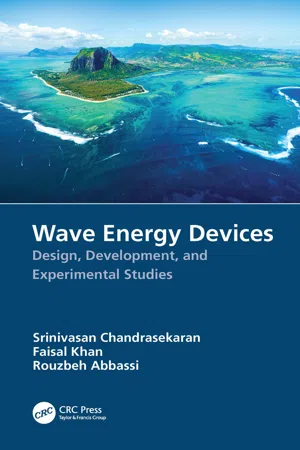
Wave Energy Devices
Design, Development, and Experimental Studies
- 259 pages
- English
- ePUB (mobile friendly)
- Available on iOS & Android
Wave Energy Devices
Design, Development, and Experimental Studies
About This Book
Designing offshore wave energy converter (WEC) devices requires a thorough understanding of many aspects of science and engineering, namely, wave hydrodynamics, wave-WEC interactions, mechanical design, analysis tools, and conducting experiments. This book provides the tools for understanding these complex systems and addresses the basic concepts of WECs through detailed analysis and design. A few devices developed and experimentally investigated are discussed in detail, some of which are considered highly novel and still in the preliminary stages of study in the existing literature.
FEATURES
-
- Offers numerous detailed design methods and practical model studies
-
- Presents analysis of the dynamic response behavior of WECs based on experimental studies on scale models
-
- Covers the most recent and novel innovations in the field
-
- Includes a discussion of offshore wind farms as a green energy alternative and examines their conceptual development and design
This book serves as a useful guide for both academicians and professionals in naval architecture and offshore engineering as well as in civil and structural engineering. In addition, it helps in the understanding of structural behavior in terms of risk criteria, efficiency, service life, and reliability. Readers will gain a comprehensive knowledge of the design and development of offshore wave energy devices and the preliminary design of offshore wind turbines, which are currently largely absent in the scientific literature.
Frequently asked questions
Information
1 Ocean Waves and Wind Forces Basics
1.1 Ocean Environment
Table of contents
- Cover
- Half-Title Page
- Title Page
- Copyright Page
- Table of Contents
- Preface
- Authors
- 1 Ocean Waves and Wind Forces: Basics
- 2 Perforated Cylinders and Applications
- 3 Floating Wave Energy Converter
- 4 Double-Rack Mechanical Wave Energy Converter
- 5 Offshore Wind Turbines
- References
- Index